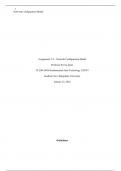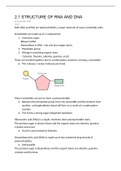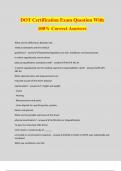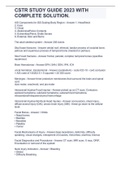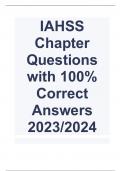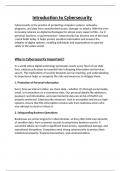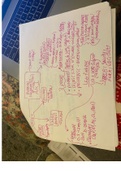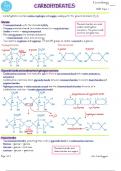CHAPTER 13:
Correlation: association (or relationship) between two scale/quantitative variables (not an IV
and DV)
o Can display this relationship visually in a scatterplot
o Not really about causality
o Line of best fit or “regression line” to make predictions about values not measured
Bivariate distribution: Joint distribution of two variables
o scores are paired
o Typically the same person provides 2 scores: one for each variable
Types of correlation: Correlation just detects linear relationships and depends on how you
operationalize the variable
o Positive correlation: high score on one variable and high score on the other OR low
score on one and low on the other (they vary together)
o Negative correlation: scores vary in a way that is opposite, low score on one variable
comes with high score on the other
o Zero correlation: the null hypothesis, no association between variables (cloud of
points or a straight line parallel to the x-axis)
o Perfect correlation: all points fall in a straight line, perfect prediction
Correlation coefficient: “r” - statistic that quantifies the relation between two variables
o Measure of tendency for paired scores to vary systematically
High-high; low-low
High-low; low-high
o Variance: tendency of sample scores to depart from sample mean
o Covariance: tendency of scores to fall on same side of the mean or opposite sides of the
mean
If scores tend to fall on same side of mean product of paired deviation
scores will be positive
If scores tend to fall on opposite sides of the mean product of paired
deviation scores will be negative
If scores tend to fall far from the mean product of paired deviation scores
will be large
If scores tend to fall close to the mean product of paired deviation scores
will be small
, What about units of measurement? We need to standardize
X−M
o Z= - reflects standard deviation from the mean
SD
o “Pearson’s Product Moment Correlation Coefficient” aka R =
Σ ( X−M variable 1 ) ( X −M variable 2 )
SD × SD
positive or negative, ranges from -1 to +1
0 means no relationship (dot cloud or straight horizontal line)
It’s strength (magnitude) of coefficient, not sign, that indicates how large it is
Correlation ≠ Causation:
o Causality requires manipulation of a variable to test its impact
o At least three possible causal explanations for a correlation
AB
BA
C A and B
o So typically with research designs that use correlation analyses, we are not inferring
causality, just an association
Correlations can be used to test:
o Reliability: consistency of its measurement (test and retest reliability – score from
time #1 and score from time #2)
o Validity: accuracy of measurement – does it measure what we want to measure
(correlation between two measures which should be correlated and measure the same
thing)
Calculating R:
o Start with a scatterplot
NUMERATOR:
Correlation: association (or relationship) between two scale/quantitative variables (not an IV
and DV)
o Can display this relationship visually in a scatterplot
o Not really about causality
o Line of best fit or “regression line” to make predictions about values not measured
Bivariate distribution: Joint distribution of two variables
o scores are paired
o Typically the same person provides 2 scores: one for each variable
Types of correlation: Correlation just detects linear relationships and depends on how you
operationalize the variable
o Positive correlation: high score on one variable and high score on the other OR low
score on one and low on the other (they vary together)
o Negative correlation: scores vary in a way that is opposite, low score on one variable
comes with high score on the other
o Zero correlation: the null hypothesis, no association between variables (cloud of
points or a straight line parallel to the x-axis)
o Perfect correlation: all points fall in a straight line, perfect prediction
Correlation coefficient: “r” - statistic that quantifies the relation between two variables
o Measure of tendency for paired scores to vary systematically
High-high; low-low
High-low; low-high
o Variance: tendency of sample scores to depart from sample mean
o Covariance: tendency of scores to fall on same side of the mean or opposite sides of the
mean
If scores tend to fall on same side of mean product of paired deviation
scores will be positive
If scores tend to fall on opposite sides of the mean product of paired
deviation scores will be negative
If scores tend to fall far from the mean product of paired deviation scores
will be large
If scores tend to fall close to the mean product of paired deviation scores
will be small
, What about units of measurement? We need to standardize
X−M
o Z= - reflects standard deviation from the mean
SD
o “Pearson’s Product Moment Correlation Coefficient” aka R =
Σ ( X−M variable 1 ) ( X −M variable 2 )
SD × SD
positive or negative, ranges from -1 to +1
0 means no relationship (dot cloud or straight horizontal line)
It’s strength (magnitude) of coefficient, not sign, that indicates how large it is
Correlation ≠ Causation:
o Causality requires manipulation of a variable to test its impact
o At least three possible causal explanations for a correlation
AB
BA
C A and B
o So typically with research designs that use correlation analyses, we are not inferring
causality, just an association
Correlations can be used to test:
o Reliability: consistency of its measurement (test and retest reliability – score from
time #1 and score from time #2)
o Validity: accuracy of measurement – does it measure what we want to measure
(correlation between two measures which should be correlated and measure the same
thing)
Calculating R:
o Start with a scatterplot
NUMERATOR:

